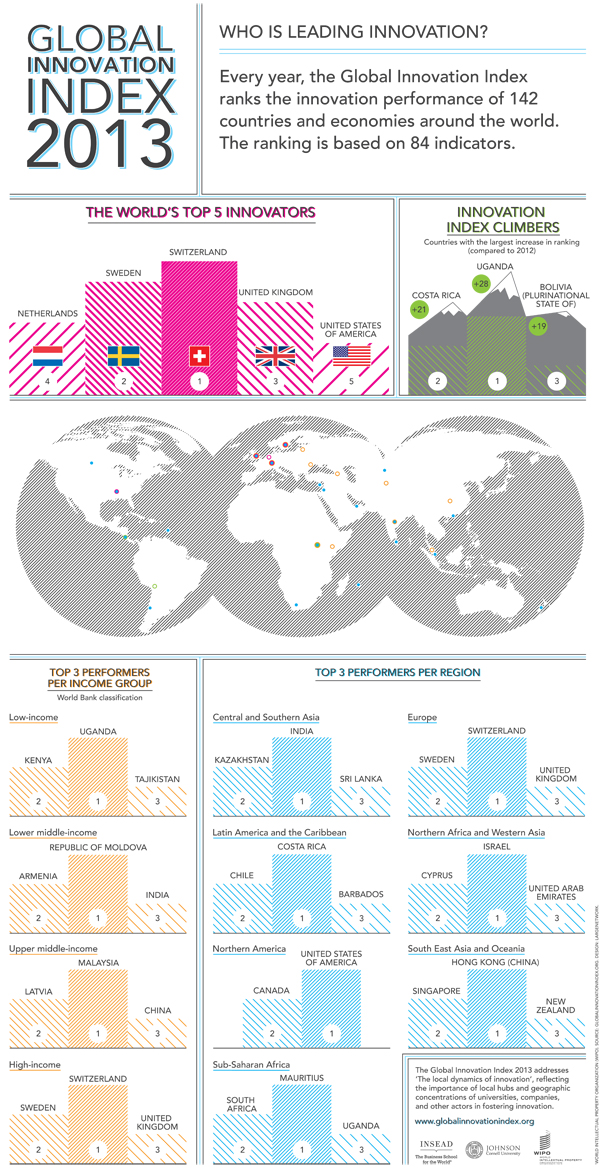Ireland has just about managed to edge into the top 10 listing in the 2013 edition of the Global Innovation Index released today by the World Intellectual Property Organization (WIPO). Ireland comes in 10th on the list, while Switzerland has retained pole position for innovation.
In total, the report evaluated 142 economies around the world for their innovation prowess.
The Global Innovation Index 2013 findings have been released jointly by WIPO, Cornell University and INSEAD. Last year, Ireland came ninth in the innovation leaderboard.
While Switzerland retained top spot, Sweden came second in the Global Innovation Index. The UK has been ranked third, followed by The Netherlands. The US took fifth spot.
In the second half of the leaderboard, Finland came sixth, followed by Hong Kong, Singapore, Denmark and, finally, Ireland in 10th spot.
Despite the global economic crisis, WIPO said innovation is alive and well.
According to the analysis, research and development spending levels are surpassing 2008 levels in most countries and successful local hubs are thriving.
A group of “dynamic” middle- and low-income countries – including China, Costa Rica, India, and Senegal – are outpacing their peers, but haven’t broken into the top of the 2013 innovation leaderboard, WIPO reported.
Emergence of innovation ecosystems in nations such as Ireland
This year’s report casts additional light on the local dynamics of innovation, an area WIPO said has remained under-measured globally.
It shows the emergence of original innovation ecosystems, and signals a needed shift from a usual tendency to try and duplicate previously successful initiatives.
“Dynamic innovation hubs are multiplying around the world despite the difficult state of the global economy. These hubs leverage local advantages with a global outlook on markets and talent.” said WIPO director-general Francis Gurry.
“For national-level policy-makers seeking to support innovation, realising the full potential of innovation in their own backyards is often a more promising approach than trying to emulate successful innovation models elsewhere.”
Measuring the innovation indicators in 142 global economies
The 2013 report used 84 indicators, including the quality of top universities, availability of microfinance and venture capital deals, gauging both innovation capabilities and measurable results.
The Global Innovation Index has been published annually since 2007.
For this year’s study, the report’s researchers drew upon experience from the likes of Booz & Company, the Confederation of Indian Industry, du and Huawei, as well as of an advisory board of 14 international experts.
United Nations secretary-general Ban Ki-moon joined the authors of the report in presenting the GII 2013 findings at the High-Level Segment of the United Nation’s Economic and Social Council.
The High Level Segment, held from 1-4 July in Geneva, brings together heads of state, ministers and heads of international agencies.
This year, the event is focusing on the role of science, technology and innovation and the potential of culture in achieving the Millennium Development Goals and promoting sustainable development.
Top Ten 2013 ranking
- Switzerland (No 1 in 2012)
- Sweden (2)
- United Kingdom (5)
- Netherlands (6)
- United States of America (10)
- Finland (4)
- Hong Kong (China) (8)
- Singapore (3)
- Denmark (7)
- Ireland (9)
The findings explained by infographic

Broken down
Switzerland and Sweden’s performance reflects the fact that both countries are leaders in all components (pillars) of the GII, consistently ranking in the top 25, according to WIPO.
The report’s authors said United Kingdom has a well-balanced innovation performance (ranking 4th in both input and output), in spite of a relatively low level of growth in labor productivity.
Meanwhile, the US appears to be continuing to benefit from its strong education base (especially in terms of top-rank universities). The US economy has seen strong increases in software spending and employment in knowledge-intensive services, reported WIPO.
Global nature of innovation
“The results of the GII [Global Innovation Index] provide testimony to the global nature of innovation today. The top 25 ranked countries on the GII are a mix of nations from across the world – North America, Europe, Asia, Oceania and the Middle East,” stressed Soumitra Dutta, co-editor of the report and Anne and Elmer Lindseth Dean from Samuel Curtis Johnson Graduate School of Management, Cornell University.
While high-income economies dominate the list, they said several new players have increased their innovation capabilities and outputs.
On average, it seems that high-income countries are outpacing developing countries by a wide margin across the board in terms of scores. This means that a persistent innovation divide exists, according to the report’s authors.
“Business, government and civil society all offer new solutions and fresh ways of collaborating to spur innovation at local, national and even global levels,” said Bruno Lanvin, the report’s co-editor and executive director of INSEAD’s European competitiveness initiative.
He said that innovation is rapidly becoming a “rallying symbol” for forces of progress and reform around the world.
“Although our findings show that daunting challenges remain for many new players, we also see exciting examples of innovation success, including in some of the poorest countries.
“This is a source of optimism about the future of global innovation and economic recovery,” added Lanvin.
Innovation image via Shutterstock